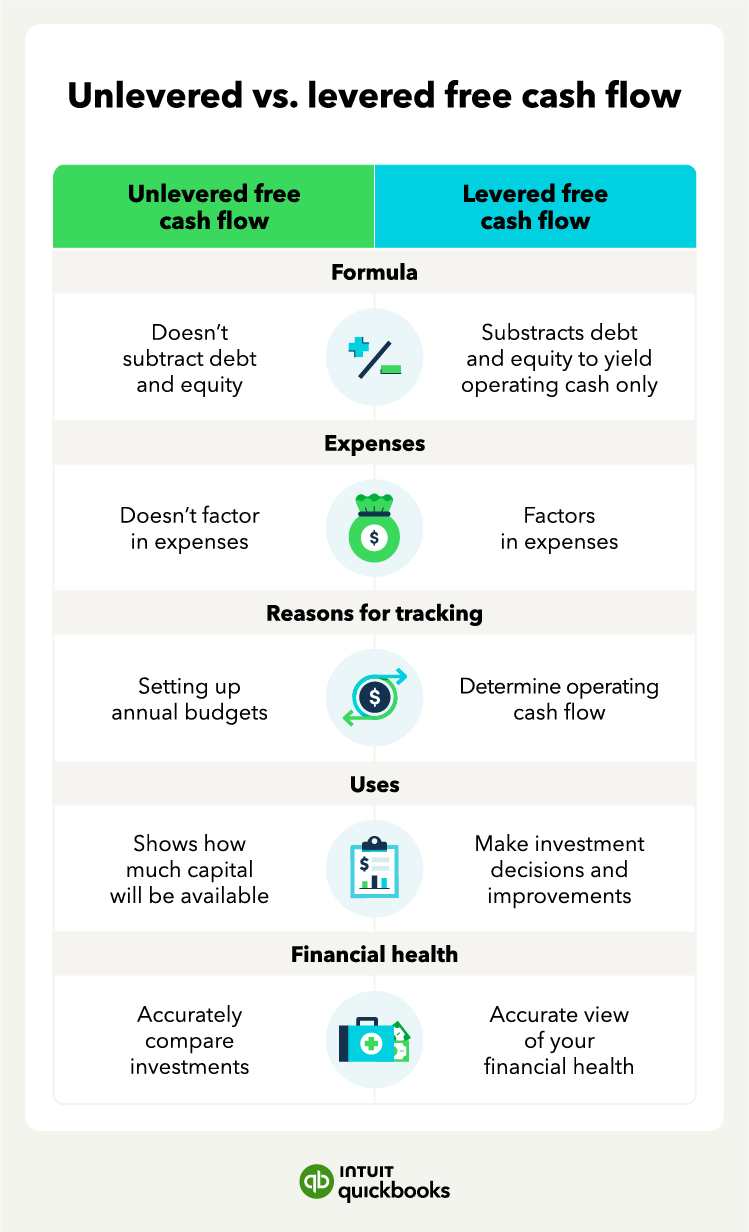Formulas
The first difference between unlevered vs. levered free cash flow is the formula. The equation for levered free cash flows is:
LFCF = EBITDA – change in net working capital – CAPEX – mandatory debt payments
The formula for unlevered free cash flow is:
UFCF = EBITDA – CAPEX – working capital – taxes
In these formulas, EBITDA represents your company’s “Earnings Before Interest, Taxes, Depreciation,” and CAPEX represents your capital expenditures, which is the money used to fund daily business activities.
As you can see, the equation for unlevered free cash flow is less extensive than the one for levered free cash flow. That’s because the levered free cash flows equation subtracts debt and equity to yield operating cash only, while unlevered free cash flows do not.
Expenses
One of the main differences between levered and unlevered free cash flow is how they treat expenses. Levered cash flows factor in expenses, such as operating expenses, debt payments, interest expenses, and taxes.
In contrast, unlevered cash flows do not factor them in. Essentially, unlevered free cash flows are what you have before expenses and levered cash flows are what you have after.
Reasons for tracking
If you have a healthy amount of debt and net working capital, then you may want to consider using levered free cash flows to determine how much operating cash flow your business has to expand.
For instance, a company can have a negative levered free cash flow if it has significant debt holders. This type of financial performance isn’t ideal, but investors shouldn’t be too wary if it's temporary. It could mean the company made significant capital investments, and they have yet to begin paying it off.
In contrast, companies often utilize unlevered free cash flows when setting up their annual budgets and determining whether or not departments are utilizing their funding effectively. If unlevered cash flow levels are too low, there’s a good chance the company will fail to satisfy its debts and, in the long run, face bankruptcy.
Additionally, a company may track UFCF to paint the business in a better light to shareholders and potential buyers. The firms that carry significant debt tend to report unlevered cash flow instead of levered cash flow. As a result, the company may appear more successful and solvent than it truly is, demonstrating a higher amount of working capital.
Uses
Unlevered free cash flow is useful for investors and prospective buyers. When investors purchase a company, one of their goals is to pay off debts to enhance the business’s long-term market value. Unlevered free cash flow reveals how much capital will be available after making interest payments and paying down the net debt balance.
Levered free cash flow is also useful for investors and prospective buyers, but instead, they use it to make investment decisions and find ways to make improvements since it shows how much cash your business has to expand. In some ways, levered cash flows are seen as the more reliable method of financial modeling as they are a better indicator of a company’s future profitability.
Financial health importance
As you can see, levered free cash flow provides a look at your company's “present value” and an accurate view of your financial health, which allows you to measure your operating income.
Unlevered free cash flows can help with budgeting and forecasting, as it shows the gross cash flow amount. This allows you to better compare the value of different investments and businesses, as some might have a higher interest expense and others don’t.
Why you should compare levered and unlevered cash flows
It’s useful for a business to regularly distinguish its levered and unlevered free cash flows. While a smaller gap between LCF and UFCF indicates that fewer funds are available for investment and expansion, a more significant difference suggests a robust and healthy business.
Additionally, the difference between unlevered and levered free cash flow can reveal whether the business has taken on too much debt. If a company is earning less than it’s paying out in expenses for a prolonged period, the odds are good that the business is in trouble.
When evaluating your company, investors may ask to see unlevered and levered cash flows. Ideally, you want to show investors unlevered cash flow projections, as this will paint your business in a better light.
Still, owners and investors shouldn’t jump to conclusions if levered free cash flow is negative or very low for a single period. As mentioned, this could mean nothing more than taking on a healthy amount of debt to expand your business.
The most important thing to consider regarding levered and unlevered cash flows is that you should conduct these analyses on your own. Doing so can give you a better look at your company’s financial health. You should look for levered and unlevered cash flow trends before making important decisions regarding your company’s financial future.
Streamline your accounting and save time
In the business world, cash is king, and a lack of liquid money can leave a company unable to pay for employee salaries and other expenditures. When you start running a business, you need to pay much more attention to in-depth financials like unlevered vs. unlevered free cash flow.
Proper financial management for small businesses will put you in a better position to secure loans and grow your company. Using accounting software can give you a quick look at everything you need to know about your company’s health and better track your finances.













